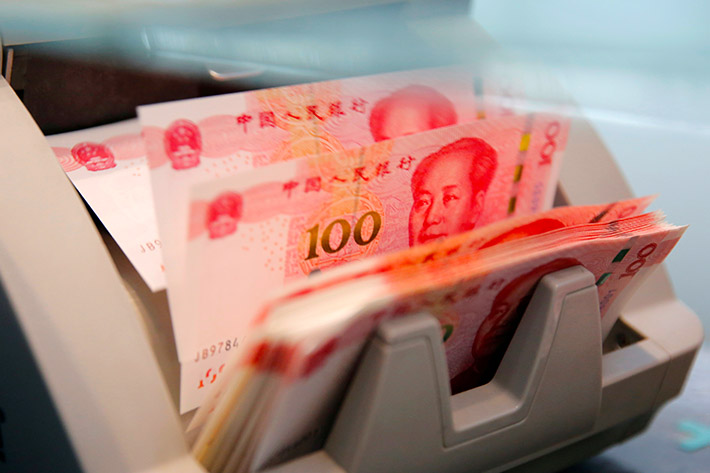The People’s Bank of China has told major state-owned banks to get ready to defend the yuan in foreign exchange markets, sources revealed late on Thursday.
The central bank wants state banks to sell dollars for the local currency in offshore markets, as it ramps up efforts to stem the yuan’s depreciating value, four sources said.
State banks were told to ask their offshore branches, including those New York, London and Hong Kong, to review their holdings of the offshore yuan and ensure US dollar reserves are ready to be deployed, according to three of the sources, who declined to be identified.
The simultaneous selling of dollars and buying of yuan could put a floor under the Chinese currency, which has lost more than 11% to the dollar so far this year and looks set for its biggest annual loss since 1994, when China unified its official and market rates.
The scale of this round of dollar selling to defend the weakening yuan will be rather big, one of the sources said.
The PBOC did not immediately respond to a request for comment.
China‘s offshore yuan immediately bounced about 200 pips after this report broke, before last trading at 7.1849 per dollar as of 0935 GMT.
ALSO SEE: China Says Stabilising Yuan is Priority, After Record Low
Concern About Domestic Sentiment
While the yuan’s depreciation has been gradual and in line with the decline in major currencies against a dollar buoyed by aggressive Federal Reserve monetary tightening, its decline to the weaker side of 7-per-dollar has raised concerns about domestic sentiment and potential capital outflows.
The offshore yuan moves in lock-step with the onshore unit, but its trading volumes account for about 70% of all yuan FX trades globally, dwarfing the volumes traded on the mainland.
Chinese authorities have intervened in the past in the offshore yuan market to steer the yuan.
Sources said the intervention plan involved using state lenders’ dollar reserves primarily. But the total amount of dollar selling is yet to be determined as the yuan’s movements are largely dependent on dollar moves and the Fed’s tightening trajectory, one source said.
China burnt through $1 trillion of its official FX reserves to prop up the currency after a one-off 2% devaluation in 2015 that roiled global financial markets.
State banks, which usually act as the PBOC’s agents in offshore markets, are scrambling to procure more dollars in offshore markets, one of the sources said.
The latest proposal follows other steps authorities have taken to put a floor under the yuan, through persistently setting firmer-than-expected mid-point fixings, verbal warnings and holding off major monetary easing efforts.
The PBOC has also rolled out policy measures this month, such as increasing the cost of shorting the currency by lowering the amount of foreign exchange financial institutions must hold as reserves and reinstating risk-reserve requirements on currencies purchased through forwards.
Earlier this week, Chinese monetary authorities told local banks to revive a yuan fixing tool it abandoned two years ago as they sought to steer and defend the weakening currency.
Rebound After 8 Days of Losses
China’s yuan rose on Thursday from a 14-year low against the dollar the previous day, ending eight straight days of losses.
The rebound occurred after the central bank issued a strong warning late on Wednesday in a bid to deter heavy one-way bets against the currency and speculative trading.
The PBOC said on Wednesday that stabilising the foreign exchange market is the top priority, and reiterated that the yuan has a solid basis to be basically stable.
The statement “illustrated PBOC’s further concerns on the rapid depreciation of the currency … (though) the PBOC would not defend a particular level of the exchange rate especially given the depreciation was driven by continued appreciation of the broad USD,” analysts at Goldman Sachs said in a note.
Prior to the market opening, the PBOC set the midpoint rate at 7.1102 per dollar, 5 pips firmer than the previous fix of 7.1107.
In the spot market, the onshore yuan opened at 7.1500 per dollar and was changing hands at 7.1903 at midday, 117 pips or 0.16% firmer than the previous late session close.
The yuan hit a low of 7.2521 per dollar on Wednesday, the weakest level since the global financial crisis of 2008.
Its offshore yuan also rebounded from its lowest level on record hit a day earlier to trade at 7.192 per dollar by midday.
‘Pressure Likely to Persist’
Currency traders said a retreat in dollar index, along with the PBOC’s verbal warnings, helped lift the yuan in morning deals.
The rare strong tone of the verbal warning discouraged many investors from testing new lows in the yuan, a trader at a foreign bank said.
Separately, the state-owned Securities Times said in a front-page commentary on Thursday that the yuan is unlikely to continue depreciating rapidly.
Market participants usually view such official remarks and state media commentaries as a sign that authorities are growing uncomfortable with rapid currency movements.
But some analysts said as long as the Federal Reserve continues to raise interest rates aggressively to tame high inflation, the yuan could still face pressure.
“We expect upward pressure on USD/CNY to persist amid aggressive Fed hikes,” analysts said. “Even though the PBOC will continue to pace the rise in USD/CNY, we expect upward pressure to take the pair to 7.20 by early 2023.”
- Reuters with additional editing by Jim Pollard
NOTE: This report was updated and the headline changed on Sept 29, 2022 with details about the PBOC plan to get state banks to defend the yuan.
ALSO SEE:
SoftBank Eyeing Arm-Samsung ‘Strategic Alliance’, Son Says






















